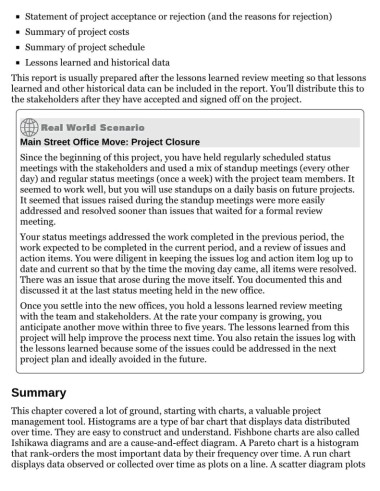Page 306 - Project+
P. 306
Statement of project acceptance or rejection (and the reasons for rejection)
Summary of project costs
Summary of project schedule
Lessons learned and historical data
This report is usually prepared after the lessons learned review meeting so that lessons
learned and other historical data can be included in the report. You’ll distribute this to
the stakeholders after they have accepted and signed off on the project.
Main Street Office Move: Project Closure
Since the beginning of this project, you have held regularly scheduled status
meetings with the stakeholders and used a mix of standup meetings (every other
day) and regular status meetings (once a week) with the project team members. It
seemed to work well, but you will use standups on a daily basis on future projects.
It seemed that issues raised during the standup meetings were more easily
addressed and resolved sooner than issues that waited for a formal review
meeting.
Your status meetings addressed the work completed in the previous period, the
work expected to be completed in the current period, and a review of issues and
action items. You were diligent in keeping the issues log and action item log up to
date and current so that by the time the moving day came, all items were resolved.
There was an issue that arose during the move itself. You documented this and
discussed it at the last status meeting held in the new office.
Once you settle into the new offices, you hold a lessons learned review meeting
with the team and stakeholders. At the rate your company is growing, you
anticipate another move within three to five years. The lessons learned from this
project will help improve the process next time. You also retain the issues log with
the lessons learned because some of the issues could be addressed in the next
project plan and ideally avoided in the future.
Summary
This chapter covered a lot of ground, starting with charts, a valuable project
management tool. Histograms are a type of bar chart that displays data distributed
over time. They are easy to construct and understand. Fishbone charts are also called
Ishikawa diagrams and are a cause-and-effect diagram. A Pareto chart is a histogram
that rank-orders the most important data by their frequency over time. A run chart
displays data observed or collected over time as plots on a line. A scatter diagram plots
306

